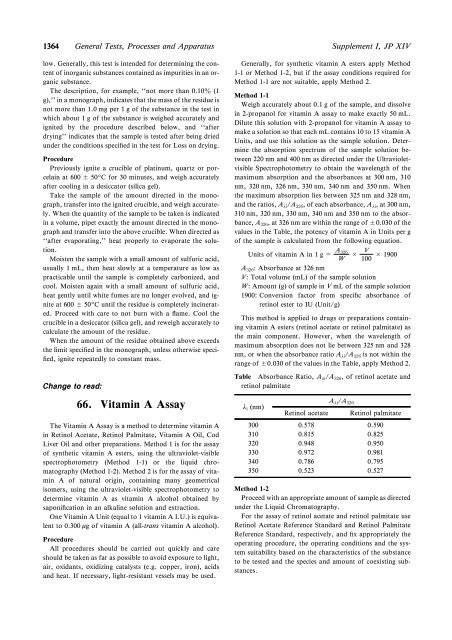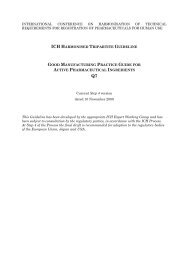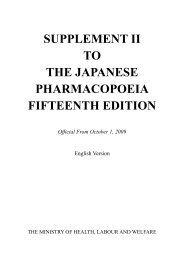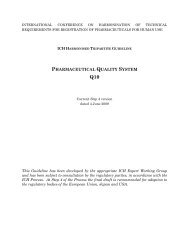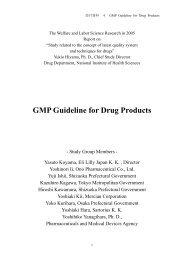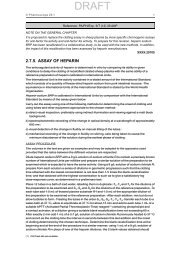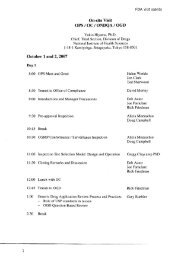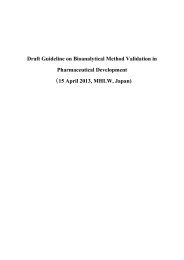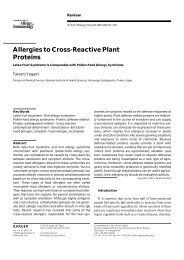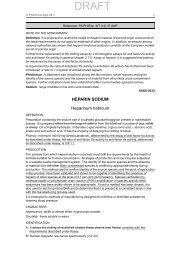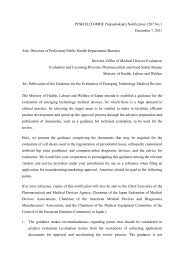Supplement I to the Japanese Pharmacopoeia Fourteenth Edition
Supplement I to the Japanese Pharmacopoeia Fourteenth Edition
Supplement I to the Japanese Pharmacopoeia Fourteenth Edition
You also want an ePaper? Increase the reach of your titles
YUMPU automatically turns print PDFs into web optimized ePapers that Google loves.
1364 General Tests, Processes and Apparatus<br />
<strong>Supplement</strong> I, JP XIV<br />
low. Generally, this test is intended for determining <strong>the</strong> content<br />
of inorganic substances contained as impurities in an organic<br />
substance.<br />
The description, for example, ``not more than 0.10z (1<br />
g),'' in a monograph, indicates that <strong>the</strong> mass of <strong>the</strong> residue is<br />
not more than 1.0 mg per 1 g of <strong>the</strong> substance in <strong>the</strong> test in<br />
which about 1 g of <strong>the</strong> substance is weighed accurately and<br />
ignited by <strong>the</strong> procedure described below, and ``after<br />
drying'' indicates that <strong>the</strong> sample is tested after being dried<br />
under <strong>the</strong> conditions speciˆed in <strong>the</strong> test for Loss on drying.<br />
Procedure<br />
Previously ignite a crucible of platinum, quartz or porcelain<br />
at 600 ± 509C for 30 minutes, and weigh accurately<br />
after cooling in a desicca<strong>to</strong>r (silica gel).<br />
Take <strong>the</strong> sample of <strong>the</strong> amount directed in <strong>the</strong> monograph,<br />
transfer in<strong>to</strong> <strong>the</strong> ignited crucible, and weigh accurately.<br />
When <strong>the</strong> quantity of <strong>the</strong> sample <strong>to</strong> be taken is indicated<br />
in a volume, pipet exactly <strong>the</strong> amount directed in <strong>the</strong> monograph<br />
and transfer in<strong>to</strong> <strong>the</strong> above crucible. When directed as<br />
``after evaporating,'' heat properly <strong>to</strong> evaporate <strong>the</strong> solution.<br />
Moisten <strong>the</strong> sample with a small amount of sulfuric acid,<br />
usually 1 mL, <strong>the</strong>n heat slowly at a temperature as low as<br />
practicable until <strong>the</strong> sample is completely carbonized, and<br />
cool. Moisten again with a small amount of sulfuric acid,<br />
heat gently until white fumes are no longer evolved, and ignite<br />
at 600 ± 509C until <strong>the</strong> residue is completely incinerated.<br />
Proceed with care <strong>to</strong> not burn with a ‰ame. Cool <strong>the</strong><br />
crucible in a desicca<strong>to</strong>r (silica gel), and reweigh accurately <strong>to</strong><br />
calculate <strong>the</strong> amount of <strong>the</strong> residue.<br />
When <strong>the</strong> amount of <strong>the</strong> residue obtained above exceeds<br />
<strong>the</strong> limit speciˆed in <strong>the</strong> monograph, unless o<strong>the</strong>rwise speci-<br />
ˆed, ignite repeatedly <strong>to</strong> constant mass.<br />
Change <strong>to</strong> read:<br />
66. Vitamin A Assay<br />
The Vitamin A Assay is a method <strong>to</strong> determine vitamin A<br />
in Retinol Acetate, Retinol Palmitate, Vitamin A Oil, Cod<br />
Liver Oil and o<strong>the</strong>r preparations. Method 1 is for <strong>the</strong> assay<br />
of syn<strong>the</strong>tic vitamin A esters, using <strong>the</strong> ultraviolet-visible<br />
spectropho<strong>to</strong>metry (Method 1-1) or <strong>the</strong> liquid chroma<strong>to</strong>graphy<br />
(Method 1-2). Method 2 is for <strong>the</strong> assay of vitamin<br />
A of natural origin, containing many geometrical<br />
isomers, using <strong>the</strong> ultraviolet-visible spectropho<strong>to</strong>metry <strong>to</strong><br />
determine vitamin A as vitamin A alcohol obtained by<br />
saponiˆcation in an alkaline solution and extraction.<br />
One Vitamin A Unit (equal <strong>to</strong> 1 vitamin A I.U.) is equivalent<br />
<strong>to</strong> 0.300 mg of vitamin A (all-trans vitamin A alcohol).<br />
Procedure<br />
All procedures should be carried out quickly and care<br />
should be taken as far as possible <strong>to</strong> avoid exposure <strong>to</strong> light,<br />
air, oxidants, oxidizing catalysts (e.g. copper, iron), acids<br />
and heat. If necessary, light-resistant vessels may be used.<br />
Generally, for syn<strong>the</strong>tic vitamin A esters apply Method<br />
1-1 or Method 1-2, but if <strong>the</strong> assay conditions required for<br />
Method 1-1 are not suitable, apply Method 2.<br />
Method 1-1<br />
Weigh accurately about 0.1 g of <strong>the</strong> sample, and dissolve<br />
in 2-propanol for vitamin A assay <strong>to</strong> make exactly 50 mL.<br />
Dilute this solution with 2-propanol for vitamin A assay <strong>to</strong><br />
make a solution so that each mL contains 10 <strong>to</strong> 15 vitamin A<br />
Units, and use this solution as <strong>the</strong> sample solution. Determine<br />
<strong>the</strong> absorption spectrum of <strong>the</strong> sample solution between<br />
220 nm and 400 nm as directed under <strong>the</strong> Ultravioletvisible<br />
Spectropho<strong>to</strong>metry <strong>to</strong> obtain <strong>the</strong> wavelength of <strong>the</strong><br />
maximum absorption and <strong>the</strong> absorbances at 300 nm, 310<br />
nm, 320 nm, 326 nm, 330 nm, 340 nm and 350 nm. When<br />
<strong>the</strong> maximum absorption lies between 325 nm and 328 nm,<br />
and <strong>the</strong> ratios, A li /A 326 , of each absorbance, A li ,at300nm,<br />
310 nm, 320 nm, 330 nm, 340 nm and 350 nm <strong>to</strong> <strong>the</strong> absorbance,<br />
A 326 , at 326 nm are within <strong>the</strong> range of ±0.030 of <strong>the</strong><br />
values in <strong>the</strong> Table, <strong>the</strong> potency of vitamin A in Units per g<br />
of <strong>the</strong> sample is calculated from <strong>the</strong> following equation.<br />
UnitsofvitaminAin1g= A 326<br />
W × V<br />
100 × 1900<br />
A 326 : Absorbance at 326 nm<br />
V: Total volume (mL) of <strong>the</strong> sample solution<br />
W: Amount (g) of sample in V mL of <strong>the</strong> sample solution<br />
1900: Conversion fac<strong>to</strong>r from speciˆc absorbance of<br />
retinol ester <strong>to</strong> IU (Unit/g)<br />
This method is applied <strong>to</strong> drugs or preparations containing<br />
vitamin A esters (retinol acetate or retinol palmitate) as<br />
<strong>the</strong> main component. However, when <strong>the</strong> wavelength of<br />
maximum absorption does not lie between 325 nm and 328<br />
nm, or when <strong>the</strong> absorbance ratio A li /A 326 is not within <strong>the</strong><br />
range of ±0.030 of <strong>the</strong> values in <strong>the</strong> Table, apply Method 2.<br />
Table Absorbance Ratio, A li /A 326 , of retinol acetate and<br />
retinol palmitate<br />
l i (nm)<br />
300<br />
310<br />
320<br />
330<br />
340<br />
350<br />
A li /A 326<br />
Retinol acetate Retinol palmitate<br />
0.578<br />
0.815<br />
0.948<br />
0.972<br />
0.786<br />
0.523<br />
0.590<br />
0.825<br />
0.950<br />
0.981<br />
0.795<br />
0.527<br />
Method 1-2<br />
Proceed with an appropriate amount of sample as directed<br />
under <strong>the</strong> Liquid Chroma<strong>to</strong>graphy.<br />
For <strong>the</strong> assay of retinol acetate and retinol palmitate use<br />
Retinol Acetate Reference Standard and Retinol Palmitate<br />
Reference Standard, respectively, and ˆx appropriately <strong>the</strong><br />
operating procedure, <strong>the</strong> operating conditions and <strong>the</strong> system<br />
suitability based on <strong>the</strong> characteristics of <strong>the</strong> substance<br />
<strong>to</strong> be tested and <strong>the</strong> species and amount of coexisting substances.


